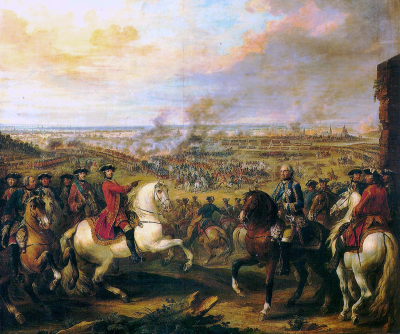The Battle of Fontenoy was a major engagement of the War of the Austrian Succession, fought on 11 May 1745, 8 kilometres (5.0 mi) outside Tournai, Belgium. A French army of 50,000 under Marshal Saxe defeated a Pragmatic Army of 52,000, led by the Duke of Cumberland. Along with his son the Dauphin, Louis XV of France was present and thus technically in command, a fact later used to bolster the regime's prestige.
At the end of 1744, the French were struggling to finance the war but held the initiative in the Austrian Netherlands. This offered the best opportunity for a decisive victory, and in late April 1745 they besieged Tournai. Its position on the upper Scheldt made it a vital link in the North European trading network, and Saxe knew the Allies would have to attempt its relief.
Leaving 22,000 men in front of Tournai, Saxe placed his main force in the villages of St Antoine, Vezin and Fontenoy, along a naturally strong feature which he strengthened with defensive works. After a number of unsuccessful flank assaults, the Allies attacked the French centre with an infantry column of 15,000 men. A series of cavalry charges and counterattacks by the Irish Brigade and Gardes Franaises inflicted heavy casualties, and forced them to withdraw.
The Allies retreated toward Brussels, leaving the French in control of the battlefield; Tournai fell shortly afterwards, quickly followed by Ghent, Oudenarde, Bruges, and Dendermonde. In October, British troops were withdrawn to deal with the 1745 Jacobite Rising, facilitating the capture of Ostend and Nieuwpoort; by the end of 1745, France occupied much of the Austrian Netherlands, threatening British links with Europe. Saxe cemented his reputation as one of the most talented generals of the era, and restored French military superiority in Europe.
However, by December 1745, Louis XV's Finance Minister warned him France faced bankruptcy, leading to peace talks in May 1746 at the Congress of Breda. Despite victories at Rocoux in 1746, Lauffeld in 1747, and Maastricht in 1748, the cost of the war and the British naval blockade meant the French economic position continued to deteriorate. As a result, their gains in the Austrian Netherlands were returned after the Treaty of Aix-la-Chapelle in November 1748.
The War of the Austrian Succession (German: Österreichischer Erbfolgekrieg) was the last great power conflict with the Bourbon-Habsburg dynastic conflict at its heart. It occurred from 1740 to 1748 and marked the rise of Prussia as a major power. Related conflicts included King George's War, the War of Jenkins' Ear, the First Carnatic War and the First and the Second Silesian Wars.
The pretext for the war was Maria Theresa's right to inherit her father Emperor Charles VI's crown in the Habsburg Monarchy, but France, Prussia and Bavaria really saw it as an opportunity to challenge the Habsburg power. Maria Theresa was backed by Britain, the Dutch Republic and Hanover, which were collectively known as the Pragmatic Allies. As the conflict widened, it drew in other participants, among them Spain, Sardinia, Saxony, Sweden and Russia.
There were four primary theatres of the war: Central Europe, the Austrian Netherlands, Italy, and the seas. Prussia occupied Silesia in 1740 and repulsed Austrian efforts to regain it, and between 1745 and 1748, France conquered most of the Austrian Netherlands. Elsewhere, Austria and Sardinia defeated Spanish attempts to regain territories in Northern Italy, and by 1747, a British naval blockade was crippling French trade.
The war ended with the Treaty of Aix-la-Chapelle (1748) by which Maria Theresa was confirmed as Archduchess of Austria and Queen of Hungary. The treaty reflected that stalemate since most of the commercial issues that had led to the war were left unresolved, and many of the signatories were unhappy with the terms. Although the war had nearly bankrupted the state, Louis XV of France withdrew from the Low Countries for minimal benefit, to the dismay of France's nobility and populace. The Spanish considered their gains in Italy inadequate since they had failed to recover Menorca or Gibraltar and viewed the reassertion of British commercial rights in the Americas as an insult.
Although Maria Theresa was acknowledged as her father's heir, she did not consider that a concession and deeply resented Britain's role in forcing her to cede Silesia to Prussia. For British statesmen, the war demonstrated the vulnerability of George II's German possession of Hanover to Prussia, and many politicians considered they had received little benefit from the enormous subsidies paid to Austria.
The result was the realignment known as the Diplomatic Revolution in which Austria aligned itself with France, which marked the end of their centuries-old enmity, and Prussia became an ally of Britain. The new alliances fought the Seven Years' War in the following decade.

1745May, 11
War of the Austrian Succession: Battle of Fontenoy: French forces defeat an Anglo-Dutch-Hanoverian army.
Choose Another Date
Events on 1745
- 18Feb
Sunanate of Surakarta
The city of Surakarta, Central Java is founded on the banks of Bengawan Solo River, and becomes the capital of the Sunanate of Surakarta Hadiningrat. - 11May
Battle of Fontenoy
War of the Austrian Succession: Battle of Fontenoy: French forces defeat an Anglo-Dutch-Hanoverian army. - 28Jun
Siege of Louisbourg (1745)
A New England colonial army captures the French fortifications at Louisbourg (New Style). - 19Aug
Battle of Kars (1745)
Ottoman-Persian War: In the Battle of Kars, the Ottoman army is routed by Persian forces led by Nader Shah. - 8Nov
Battle of Culloden
Charles Edward Stuart invades England with an army of ~5000 that would later participate in the Battle of Culloden.

 English
English  español
español  français
français  português
português  русский
русский  العربية
العربية  简体中文
简体中文 